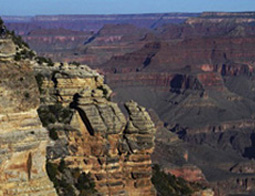 The Grand Canyon of the Colorado River is the largest gorge in the world-a 290-mile-long gash across the face of the Colorado Plateau in northern Arizona. Rim to rim, it measures up to 18 miles across, with an average width of 10 miles; its average depth is one mile. Within this Delaware-size area of eroded rock rise mountains higher than any in the eastern United States and dark walls of gorges millions of years old. Agent of this scene, the Colorado River drops 2,200 feet over nearly 200 rapids as it roars through the Canyon toward the The Grand Canyon of the Colorado River is the largest gorge in the world-a 290-mile-long gash across the face of the Colorado Plateau in northern Arizona. Rim to rim, it measures up to 18 miles across, with an average width of 10 miles; its average depth is one mile. Within this Delaware-size area of eroded rock rise mountains higher than any in the eastern United States and dark walls of gorges millions of years old. Agent of this scene, the Colorado River drops 2,200 feet over nearly 200 rapids as it roars through the Canyon toward the
Gulf of California.
The Grand Canyon is not only a slice of North America's geologic history but also a cross section of ecozones. Between rim and river, travelers find the same variety of ecological regions they would encounter on a trip from Canada to Mexico - from the snowy evergreen woods of the boreal zone to the arid depths of the lower Sonoran, where summer temperatures soar above 100 degrees and tenacious shrubs like creosote and ocotillo predominate. In all, the Grand Canyon provides rich and diverse habitatfor more than 400 vertebrate species and 1,500 plants.
 The human presence here stretches back at least 4,000 years, beginning with hunter-gatherers who deposited delicate split-willow animal figures in limestone caves. Before disappearing about A.D. 1150, ancient Pueblo peoples who had lived in and around the canyon for a millennium or more left a rich legacy of pottery, baskets, pictographs, and granaries and other structures in thousands of sites. The Havasupai people in the region today trace their presence back hundreds of years. The human presence here stretches back at least 4,000 years, beginning with hunter-gatherers who deposited delicate split-willow animal figures in limestone caves. Before disappearing about A.D. 1150, ancient Pueblo peoples who had lived in and around the canyon for a millennium or more left a rich legacy of pottery, baskets, pictographs, and granaries and other structures in thousands of sites. The Havasupai people in the region today trace their presence back hundreds of years.
During the 20th century, humans have had a far more profound impact on the Grand Canyon than in all of the past. By 1900, the canyon was already a well-known destination, thanks to written accounts by explorers and scientists and to the glowing canvases of Thomas Moran. And after Grand Canyon National Park was established in 1919, the number of visitors continued to increase exponentially:About five million people now visit the canyon each year by car, on foot, atop mules, on motorized rafts, and in helicopters. Some of the human impact, such as the view-marring haze drifting in from power plants and urban centers, has been indirect. In 1963, the Glen Canyon Dam ended the Colorado River's free flow at the Grand Canyon's entrance, and that single action has changed the canyon more than any
other event in human times.
|

